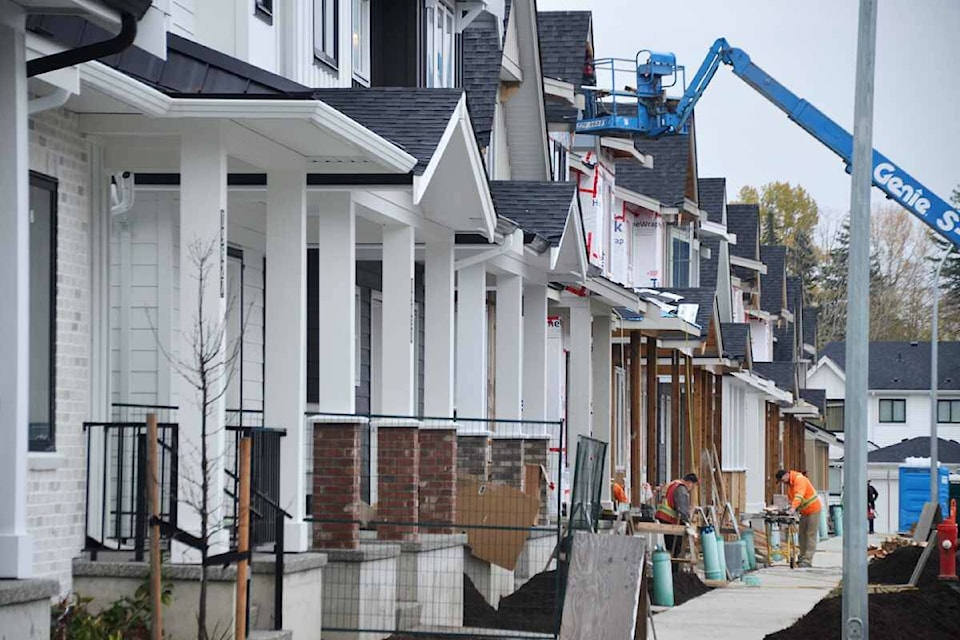A housing policy expert said there are still a lot of unknowns after new regulations effectively ended single-family zoning here in Langley, and across most of British Columbia.
There are questions about financing, strata organizations, heritage preservation, and even the capacity of sewage and water systems to answer, said Andy Yan, a professor in the SFU Urban Studies Program and director of the school’s City Program.
New regulations from B.C.’s Minister of Housing Ravi Kahlon are part of a package of reforms that have been introduced to the Legislature.
Under the proposed new legislation, lots currently designated for one house will allow for what the province calls small-scale, multi-unit housing (SSMUs). This includes secondary suites, detached laneway homes, triplexes, townhouses, and fourplexes.
Depending on setbacks and lot sizes, a minimum of three units will now be allowed on lots of less than 280 square meters, while any lot larger than that can have a minimum of four units. Furthermore, lots within 400 metres of high-frequency transit stops can have up to six units.
Almost all single-family lots in established Langley suburbs like Brookswood and Walnut Grove are well over 280 square meters in size, with Brookswood quarter-acre lots closer to 1,000 square meters.
But will developers and homebuyers flock to new types of housing once they’re allowed?
“The takeup on this project is really a thing to watch,” said Yan.
It’s unclear what this kind of new housing will look like, as there aren’t a lot of examples of four- to six-unit buildings in B.C. yet.
“What could a ‘Langley special’ look like?” Yan asked, comparing them to the Vancouver Special houses that were built by the thousands from the 1960s to the 1980s.
READ MORE: Housing legislation like surgery with a chainsaw, says Langley Township mayor
There is more than simply mandating an end to single-family zoning to creating new multi-unit housing, Yan said.
There is infrastructure demand, including adding sewage and water capacity.
Then there are governance issues – are the new units going to be rentals? If someone creates a strata-unit fourplex, how will that be managed with so few owners?
And then there’s the cost issue.
“A lot of it will depend on the financial environment,” said Yan.
High interest rates are making it a struggle to finance large development projects right now, much less smaller ones like these proposed multi-unit projects, he said.
Yan noted that communities across the region have been making moves towards similar small-scale density increases for some time.
Many communities, including Langley City and Township, have allowed secondary suites for years. There are thousands of such suites in the Township alone.
The City of Vancouver has also allowed laneway housing in recent years.
“The issue is not should or if, but how?” Yan said.
He pointed to a number of issues that will have to be ironed out.
“How does this fit into things like historic preservation zones?” said Yan.
Then there are questions about municipal financing.
Another set of proposed changes will revamp and standardize development cost charges (DCCs) and community amenity charges (CACs) across the province.
How will that impact municipal governments’ ability to raise revenue through things like density bonuses, Yan asked.
“Some of this is like somebody playing real-life Sim City,” said Yan.
He noted that change in the type of built environment can be difficult for people, and the difficulty is changing things in a way that doesn’t alienate people.
Whatever rules are put in place for housing, Yan said they should allow local communities to meet standards for inclusion, diversity, and choice.
On Thursday, Nov. 16, Kahlon announced another part of the plan for SSMUs – the province will draft up to 10 standardized designs for the new type of homes.
“Having standardized building designs available can help streamline the permitting process,” Kahlon said in the announcement. ”We will work to add additional designs in the coming years to ensure our communities remain vibrant and have a variety of housing options.”
A consultant group will work with builders, and the designs are set to be completed and released around the summer of 2024, the same time the new zoning rules are expected to take full effect.
The designs will comply with the BC Building Code, and be as close as possible to “building permit ready,” which is aimed at simplifying the process for both builders and local municipalities.
Some communities have already created standardized designs, including Kelowna, but the provincial project will allow for the creation of designs that can be broadly used, even in communities that don’t have the resources to create their own sets of plans.

